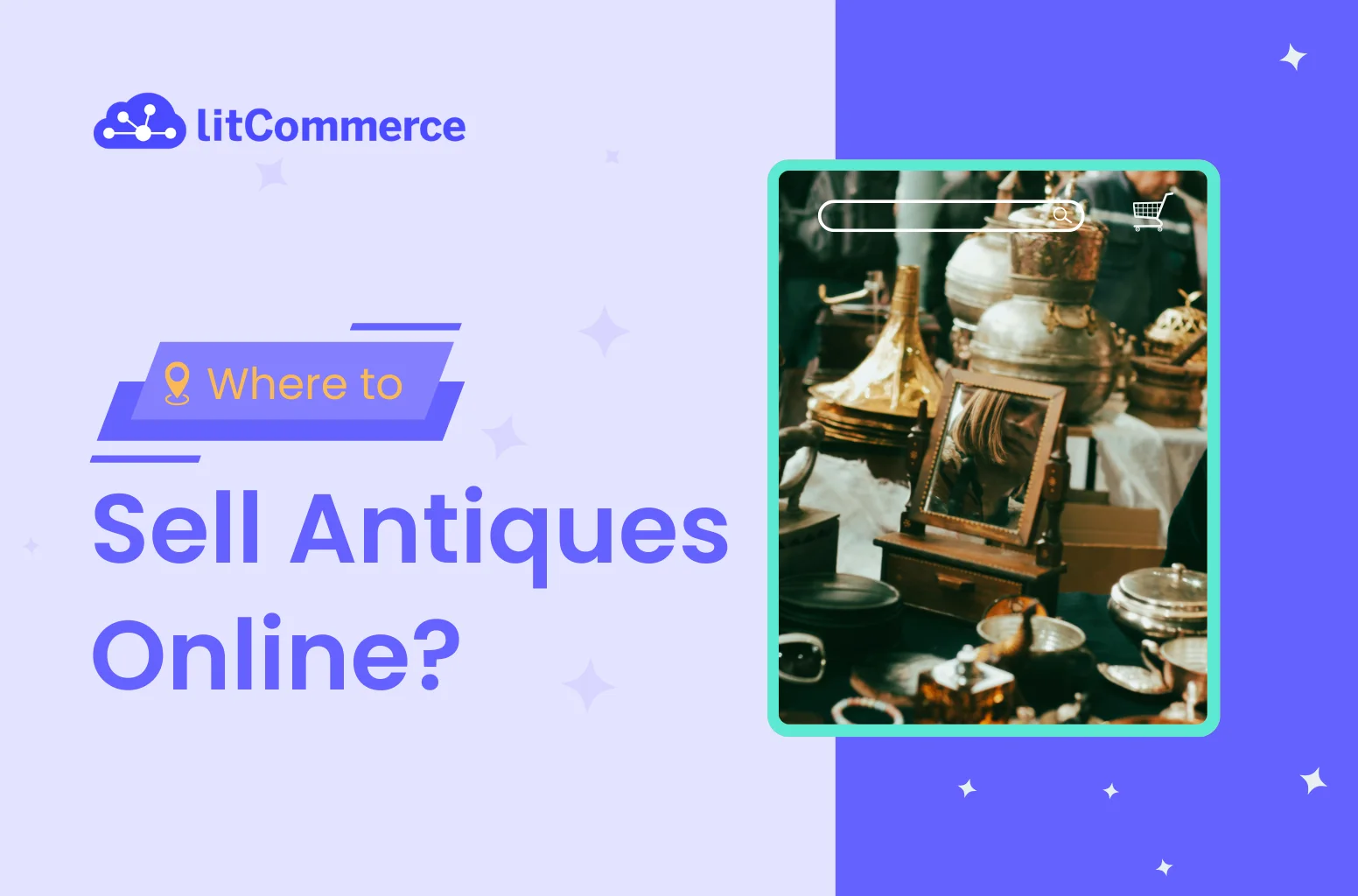As an antique seller, you have three main ways to sell: antique malls, flea markets, and selling online. However, online platforms have revolutionized the antiques and collectibles industry. Unlike traditional flea markets or local stores, these platforms offer you access to a far wider audience – regionally, nationally, and even globally. That means higher visibility, more interested buyers, and better chances of making a sale. However, that raises a big question: where to sell antiques online?
In fact, various online avenues are available. In this guide, we’ll cover everything you need to know to get started with selling antiques online, including:
- 10 best places to sell antiques online
- 5 easy steps to start selling antiques online
By finding the best place where to sell antiques, you can maximize your reach and locate the right buyers for your valuable pieces. Without further ado, let’s dive in!
How to Sell Antiques on Marketplaces
With LitCommerce, you can easily list your antiques on the channels of your choice, whether it’s Amazon, eBay, Etsy, or TikTok.
Where to Sell Antiques Online: 10 Best Marketplaces & Platforms
Selling antiques online? You’ve got plenty of options. From niche marketplaces to big eCommerce platforms and scroll-stopping social media, here are the 10 top destinations where collectors are looking and actually buying.
- #1. Etsy
- #2. eBay
- #3. Ruby Lane
- #4. Amazon
- #5. Bonanza
- #6. Craigslist
- #7. Shopify
- #8. Wix
- #9. Facebook & Instagram
- #10. TikTok
To assist in your decision-making, we have compiled a comprehensive guide to some of the top online destinations for selling antiques. Keep reading to learn where and how to sell antiques online.
#1. Etsy
Etsy, primarily known as a platform for selling handmade and crafted goods, also offers the opportunity to sell vintage and antique items. This is the best destination where to sell antiques. This marketplace allows the sale of antiques as long as they are at least 20 years old. To start selling on Etsy, register a seller account and fill in the basic information.
How much does it cost to start an Etsy shop? Opening an Etsy shop is free, but you will be charged $0.20 when listing your antique item on Etsy. In addition to the listing fee, Etsy charges a 5% commission on the final sale price, including the associated shipping cost.
Like other sites to sell antiques, presenting high-quality photos is crucial to attracting potential buyers if you want to sell antiques. Providing detailed information about your antique item, including its age, condition, and other relevant details, is essential for creating an appealing listing. In case you are uncertain about the exact age of the item, you can provide an approximate timeframe, like “circa 1980s”. Remember that anything produced before 2000 would qualify as vintage or antique and can be listed for sale on Etsy.
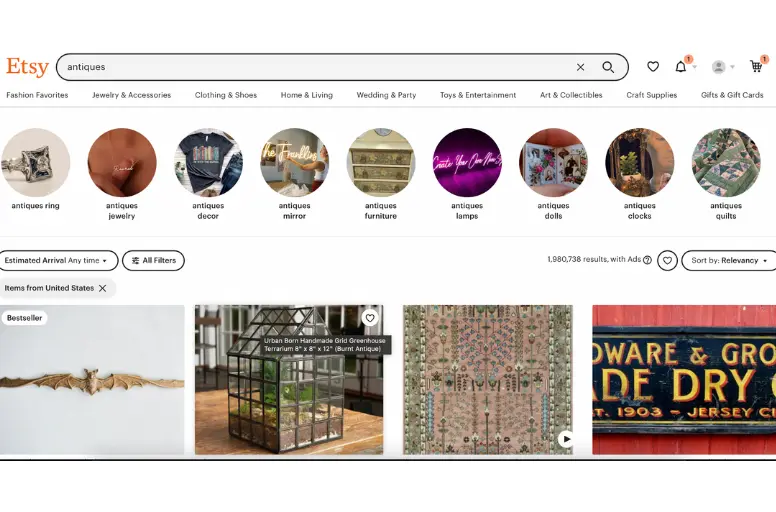
Pros:
- Targeted audiences for antiques approaching;
- User-friendly interface for easy setup and listing process;
- Access to a global customer base.
Cons:
- High competition in the antique market;
- Listing fees per item listed;
- Listing expiration after four months;
- Percentage fee charged on the final sale price.
Pricing:
- $0.20 per listing
- 5% per transaction
- Advertising fees
Is Etsy a good place to sell antiques?
Yes, Etsy is perfect for sellers offering handcrafted, custom-made, unique, or vintage items. If you’re selling antiques, your things fall within the “vintage” category on the platform. The “vintage” classification on Etsy encompasses various items, such as clothing, books, movies, music, home decor, jewelry, accessories, toys, and games.
#2. eBay
For over two decades, eBay has remained the best site to sell antiques and for individuals to showcase their collections to a vast audience.
There are numerous benefits of an eBay store when it comes to selling antiques online. With its extensive reach and user-friendly platform, eBay provides a convenient and effective way to run auctions or list antique items for sale. You can use eBay’s long-standing reputation and broad customer base to maximize exposure for your antiques and streamline the selling process.
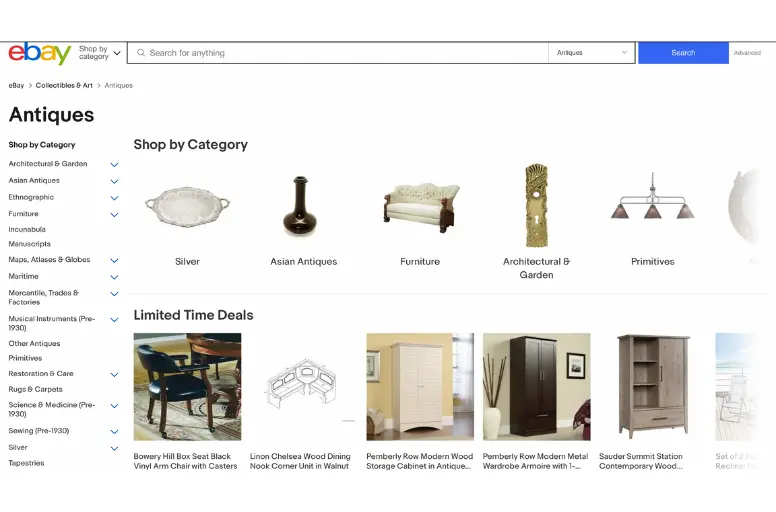
Pros:
- Access to a massive customer base, increasing the potential for sales of antiques;
- An auction format that generates excitement and competition among buyers, potentially leading to higher prices;
- No listing fees for up to 250 items per month, reducing upfront costs;
- Acceptance of PayPal payments, facilitating easy transaction tracking.
Cons:
- Need for strategic pricing and effective marketing to differentiate and stand out among other sellers;
- eBay fees are too high per transaction.
Pricing:
- Listing fees (if you list over 250 items monthly)
- 10% per transaction
- Advertisement fees
Who should sell antiques and collectibles on eBay?
Anyone with valuable antique items, including professional dealers, collectors, vintage enthusiasts, and individual sellers, can sell on eBay.
Want to Sell Antiques on eBay?
Already have a store on Shopify, Wix, or WooCommerce? With LitCommerce, you can list hundreds or even thousands of products on eBay in minutes and sync inventory automatically.
#3. Ruby Lane
Ruby Lane is one of the most respected places to sell antiques online, especially if you deal in high-end, one-of-a-kind, or vintage items. Unlike mass-market platforms, Ruby Lane is highly curated, meaning that not everyone is accepted. This makes it an ideal choice for established antique dealers or serious sellers who can meet the platform’s standards.
One of its standout features is the quality of its listings. Ruby Lane expects sellers to put in the effort: detailed product descriptions, multiple high-quality images, and accurate information are required for every item. While this makes the listing process more involved than on sites like Etsy, it creates an upscale, trust-driven marketplace that attracts serious buyers willing to pay for unique finds.
Pros
- Curated platform with a focus on high-end antiques
- Strong customer service and a reputation for quality
Cons
- High selling fees compared to other marketplaces
- Selective acceptance, making it harder for casual sellers to join
Pricing:
- Monthly maintenance fee: $45
- Service fee: 9.9% on all sales (capped per item)
Who should sell antiques on Ruby Lane?
If you’re a serious seller with high-quality antiques and don’t mind investing extra effort into curated listings, Ruby Lane is one of the best places to sell antiques online.
#4. Amazon
Amazon, one of the top marketplaces for selling products, allows sellers to list and sell antiques. Amazon sellers can sell antiques that fall under the category of used or collectible items and vintage decor. However, it’s important to note that sellers who self-fulfill orders need this Amazon approval to sell used products. If you choose to use Amazon’s FBA service, you can sell these items without facing any restrictions as long as your seller performance remains in good standing.
Selling vintage games and toys can be lucrative on Amazon, often commanding higher prices than on other platforms like eBay. You can consider these products if you are searching for an online marketplace where to sell collectibles and antiques. Do you want to start selling antiques on Amazon? Check our sell on Amazon guide to learn how to sign up for an account and list products.
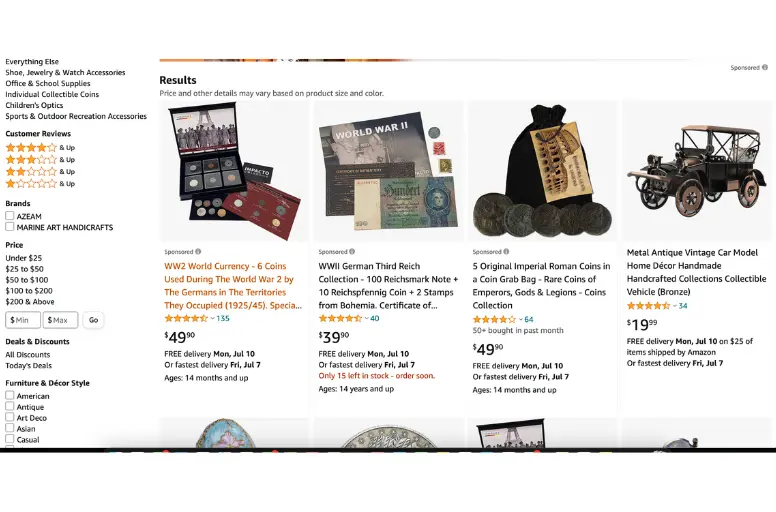
Pros:
- Access to a vast pool of potential buyers for antique items;
- Utilization of a trusted eCommerce platform increasing the chances of making sales;
- Availability of Amazon’s fulfillment services for efficient storage, packaging, and shipping logistics.
Cons:
- High competition due to the saturation of sellers offering similar antique items on Amazon;
- The incurrence of various Amazon seller fees that can impact profit margins;
- Limitation in targeting specific customers seeking antiques, as Amazon focuses not solely on this niche compared to other platforms.
Pricing:
- Seller account fees
- Referral fees (a percentage of the item’s sale price)
- Fulfillment fees (if utilizing Amazon’s fulfillment services)
- Advertising fees
Who should sell antiques on Amazon?
Anyone with valuable antique items, whether they are antique collectors, dealers, artisans, or vintage enthusiasts, can sell them on Amazon.
#5. Bonanza
Bonanza is another fantastic choice for those looking for where to sell antiques. It positioned itself as a marketplace for everything but the ordinary. One of the standout features is that there are no listing or setup fees, making it an attractive option for sellers.
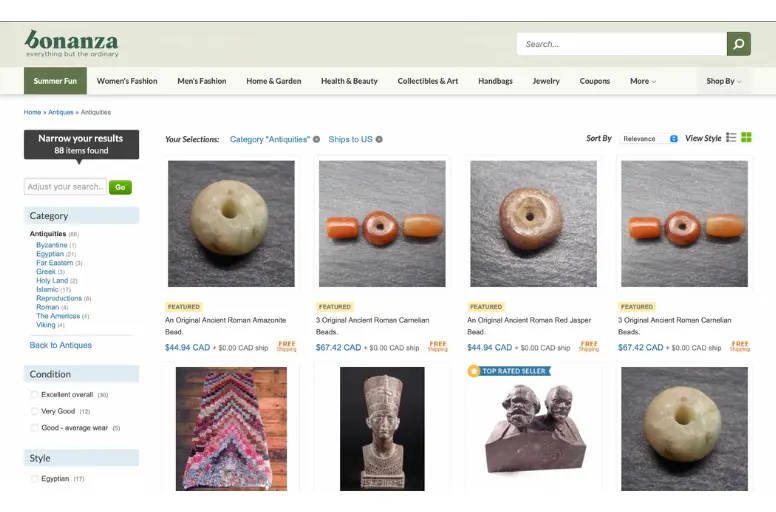
Pros:
- User-friendly interface for accessible listing and management of antique items;
- Extraordinary items focusing, making it an ideal platform to sell antiques online;
- No fees for listings and account setup, minimizing upfront costs.
Cons:
- Smaller user base compared to other platforms, potentially limiting the number of potential buyers;
- Less established reputation compared to more well-known platforms.
Pricing:
- Free for listings and account setup
- 3.5% per transaction
- 5.5% per transaction with advertisement
Who should sell on
Bonanza is a suitable platform for independent sellers of unique and vintage antiques seeking a cost-effective marketplace with niche exposure.
#6. Craigslist
Craigslist has been around since the early days of the internet, and while its design hasn’t changed much, it’s still a bustling hub for classified ads of all kinds. For antique sellers, it’s especially useful for smaller items like collectibles, vintage toys, vinyl records, or decor that appeal to local buyers.
One of Craigslist’s biggest advantages? It’s free to list most items. That makes it a low-risk option if you’re just starting out or want to clear inventory quickly. However, Craigslist does not provide escrow or integrated online payment options, meaning transactions are typically done in cash or via direct wire transfer. This often requires meeting buyers in person, which can make the selling process more hands-on, and calls for safety precautions when arranging meetups with strangers.
Pros:
- No listing fees for most item categories
- Strong local reach, great for selling antiques near you
- High traffic, with millions of users browsing daily
Cons
- No secure payment options, only cash or wire transfers
- In-person meetups required, with associated safety considerations
- Risk of scams, requiring extra caution
Selling fee:
- Fees may apply for certain categories (e.g., job posts, real estate), but antique listings remain free (no posting or commission fees)..
Who should sell on
Craigslist is a solid option for moving antiques locally without extra costs. Just remember to stay cautious when meeting buyers and handling payments.
#7. Shopify
Shopify is one of the top eCommerce platforms for selling antiques online. With over 600,000 online stores and 1 million active users worldwide, it is well-suited for large businesses. It has a strong reputation for its sales features and has facilitated over $100 billion in sales.
While it may not be the most accessible platform, it remains popular and boasts a high customer satisfaction rating of 93%. Plus, this platform offers various plan packages for sellers at different prices. For more details about Shopify pricing plans, read through our article about how much is Shopify.
To get started as a newbie, you can take advantage of Shopify’s 3-day free trial, which does not require any credit card information. If you want to learn how to open an online shop on Shopify, our Shopify tutorials for beginners will help you.
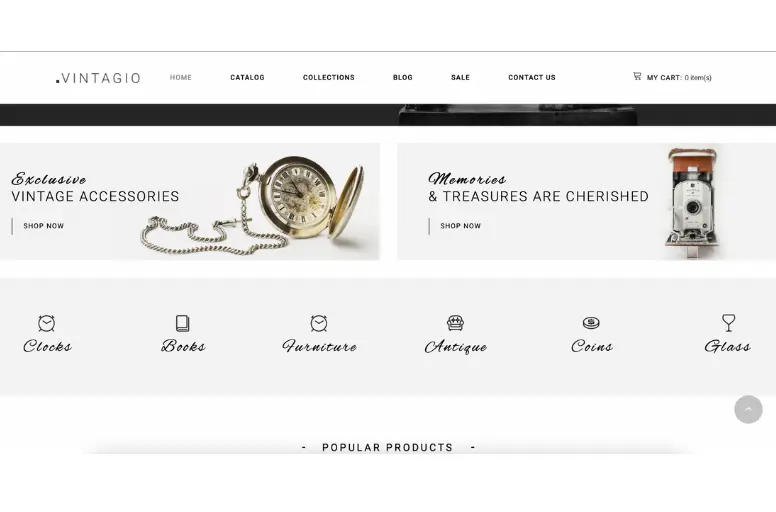
Pros:
- Easy eCommerce store creation with customizable themes;
- Mobile-optimized platform for seamless browsing and purchasing;
- Secure payment processing for customer trust and convenience;
- Efficient inventory management for organizing antique product listings;
- Marketing tools for effective promotion of antique products;
- 7. Responsive 24/7 customer support for assistance and guidance;
- Scalable platform with flexible plans and integration possibilities;
- Integration with apps and services for enhanced functionality.
Cons:
- Requiring transaction fees for each sale
- Having limited customization options for non-developers
- Charging monthly fees based on the chosen pricing plan
Pricing:
- Shopify Pricing Plans
- Shopify Starter – $5/month + 2.9% plus 30 cents per transaction
- Basic Shopify – $25/month + 2.9% plus 30 cents per transaction
- Shopify – $65/month + 2.6% plus 30 cents per transaction
- Advanced Shopify – $999/month + 2.4% plus 30 cents per transaction
- Shopify Plus – $2000/month
- Advertising fees
Who should sell on
Businesses of all sizes, from small independent antique sellers to large antique retailers, can use Shopify as their eCommerce platform.
#8. Wix
Wix, a famous website builder with over 110 million worldwide users, offers a user-friendly platform for selling antiques online. It provides a drag-and-drop interface and customizable templates, enabling antique sellers to showcase and sell their products effortlessly.
Users can create visually appealing and functional online stores without coding knowledge with intuitive design tools and pre-designed templates. Wix also offers inventory management, secure transactions, and mobile optimization to enhance the selling experience.
Moreover, this platform provides a free plan without time limitations, making it accessible for beginners to get started. If you are a small seller finding the best place where to sell antiques, you can create an online shop with Wix. Check our Wix tutorial to learn more.

Pros:
- User-friendly drag-and-drop interface for easy store customization.
- Customizing options are available for creating visually appealing stores.
- Features like inventory management and secure transactions enhance the selling experience.
- Mobile optimization ensures a seamless browsing experience on mobile devices.
Cons:
- Limited capabilities in inventory management and analytics.
- Potential scalability issues for growing stores.
- Limited customization options for advanced modifications.
- Monthly fees associated with premium plans.
Pricing:
- Wix pricing plan monthly
- Free – $0
- Combo – $16
- Unlimited – $22
- Pro – $27
- VIP – $45
- Business Basic – $27
- Business Unlimited – $32
- Business VIP – $59
- Enterprise – $500-plus
- Processing Fees: 2.9% + $0.30/ transaction
- Advertisement fees
Who should sell on
Wix is suitable for individuals, small businesses, and even medium-sized antique sellers who prioritize user-friendliness and simplicity in building their online store.
#9. Facebook & Instagram
Facebook and Instagram, with their wide-reaching audiences and robust features, provide powerful social media platforms where to sell antiques. Online businesses can take advantage of these platforms to sell directly, offering a convenient purchasing experience for their engaged audience. Mainly, on Facebook, you can utilize both Facebook Shop vs Marketplace to sell your antique items. This is particularly beneficial for brands with a substantial following on these social channels.
Selling antiques on Facebook and Instagram allows sellers to effectively showcase their products and expand their reach to a broader audience, or you can also consider creating an online catalog to display your products. It is common for businesses to complement social media selling with a dedicated online store or another eCommerce platform, enhancing their overall selling strategy.
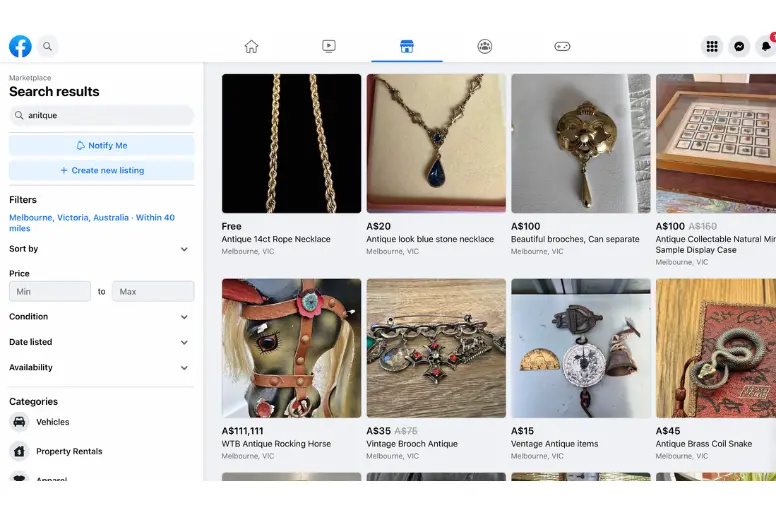
Pros:
- Broad reach to a large and engaged audience
- Effective showcasing of antique products through visual content
- Direct engagement and communication with potential customers
- Targeted advertising options for reaching specific audiences interested in antiques
Cons:
- High competition from other antique sellers on the platforms
- Organic reach may be affected by algorithm changes
- Limited customization options for store design and layout
- Transaction fees may apply for using built-in shopping features or third-party payment processors
Pricing:
- Free for setting and listings
- Advertising fees for promoting and selling antiques
Who should sell on
Facebook and Instagram suit antique sellers of all sizes, including individuals, small businesses, and established antique dealers. It is especially beneficial for sellers who want to leverage social media’s visual nature and engage directly with potential customers.
#10. TikTok
TikTok, the popular short-form video platform, can be used to sell antiques online. With its massive user base and viral potential, TikTok offers a unique opportunity to showcase and promote antique products through creative videos. That’s not all! TikTok sellers can also utilize the live stream function to engage directly with the audience, provide demonstrations, share stories, and ultimately sell their unique pieces. You can choose between a TikTok business account and a personal account to get started with your business.
On Tiktok, sellers can leverage their visual storytelling capabilities and engage with a younger, trend-oriented audience to increase brand visibility and reach potential customers.

Pros:
- Quick and cost-effective reach to the target audience
- High conversion rates from viewers to customers
- Endless creative opportunities on TikTok
- Straightforward content repurposing for other platforms
Cons:
- Potentially expensive ad costs for small businesses.
- Uncertainty of reaching the target audience.
- Short-form videos may only suit some business types.
- Potential mismatch with a brand reputation on TikTok.
Pricing:
- Free to open a shop
- 2% per transaction
Who should sell on
Individuals, small businesses, and brands targeting a younger, trend-oriented audience and seeking to engage with them through creative and visually appealing content can benefit from selling on TikTok.
How to Sell Antiques Online in 5 Simple Steps
So you’ve figured out where to sell antiques online, now let’s discover how to do it like a pro. Selling antiques online isn’t just posting a photo and hoping for the best. It’s about presenting them well, pricing smartly, and reaching the right buyers.
Here’s how to sell antiques online in just 5 steps:
#Step 1: Create an online antiques store
Whether you choose to sell your antiques on a specialized marketplace (like Ruby Lane or Etsy), a bigger platform (like eBay or Amazon), or build your own eCommerce store (on Shopify or Wix), the first step is to create your online store.
Each platform may require different details, but generally, you’ll need to choose a business name, design a logo, and set up a store theme that reflects your brand. A well‑organized, professional-looking store helps build trust and makes buyers more confident in purchasing from you.
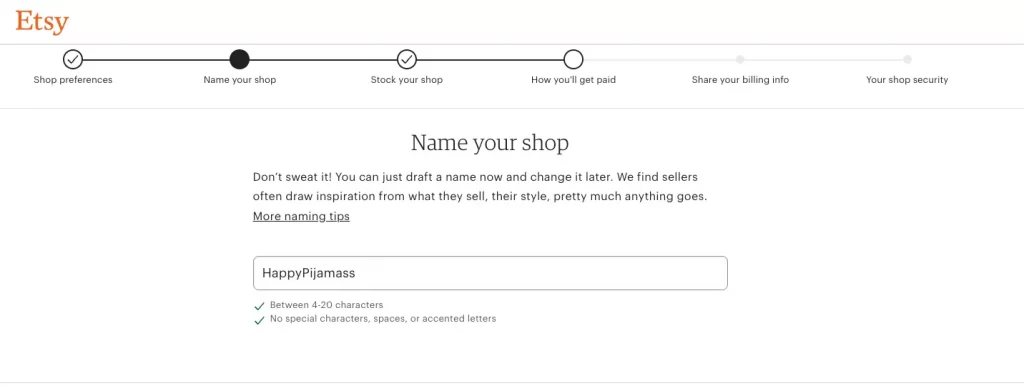
#Step 2: Set up your product pages
Once your store is ready, the next step on how to sell antiques online is to set up your product pages. Think of these pages as your online showroom, a place where buyers can truly appreciate the beauty, history, and uniqueness of your antiques.
When selling antiques, remember that story and craftsmanship often matter more than function. Your listings should make buyers feel like they’re discovering something special. Here’s how to do it:
- Product titles and descriptions: Use clear, simple language that helps buyers picture owning the piece. Go beyond the basics by adding context – its era, maker, history, or unique features – so it feels like more than just “an antique.”
- Product images: Don’t settle for a quick snapshot. Use natural light, capture multiple angles, and zoom in on noteworthy details, such as patina, engravings, or craftsmanship. If there’s a story behind the wear or design, show it visually.
A well-crafted product page not only informs but inspires antique buyers, turning casual browsers into serious collectors.
#Step 3: Determine the value of your antiques & price them fairly
Pricing antiques can be challenging because numerous factors come into play, including age, condition, rarity, and market demand.
So, how can I find out what my antiques are worth?
Start by researching similar items that have recently sold. Look for antiques in comparable condition and note their prices. This will help you establish a realistic price range for your own pieces. Over time, you’ll develop a better feel for valuing antiques and learn how to spot pricing patterns in the market.
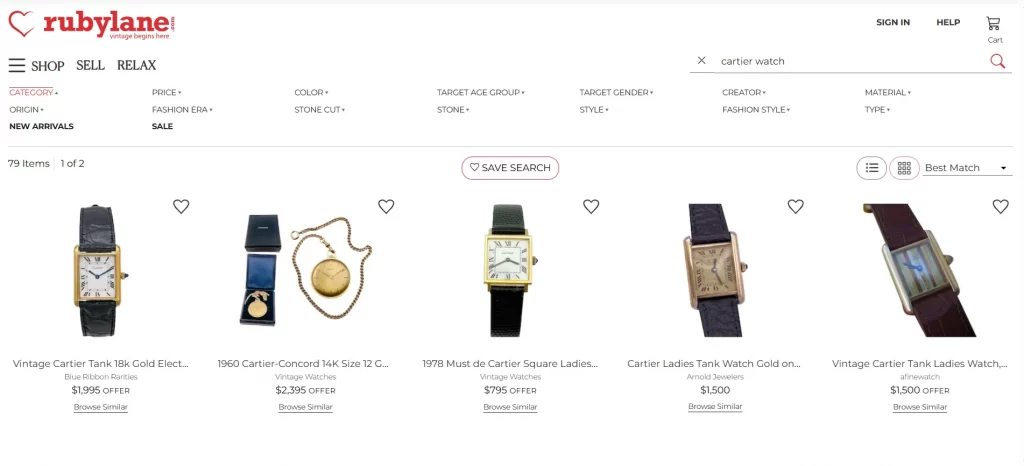
If you’re unsure or dealing with high-value pieces, consider hiring a professional antique appraiser. They can provide expert insights and accurate valuations. While this comes with an added cost, it can give you peace of mind, help you price competitively, and even teach you strategies for evaluating your future inventory.
#Step 4: Package and ship with care
Antiques are precious, and your packaging should prove it. Use sturdy boxes, bubble wrap, and fillers for extra security. Offer tracked shipping and, for high-value items, consider insurance. Buyers will appreciate knowing their treasures are safe.
#Step 5: Market your antiques to the right audience
Having great antiques is only half the job – the real challenge is getting them in front of the right buyers. Here’s how to make it happen:
- Sponsored listings: Many marketplaces like eBay, Etsy, and even Craigslist allow you to promote your items with paid listings. This can put your antiques at the top of search results, helping you reach active buyers faster.
- Social media (ads): Platforms like Instagram, Facebook, and TikTok are perfect for showcasing visually appealing antiques. Use targeted ads to reach collectors who already have an interest in vintage and one‑of‑a‑kind pieces.
- Search engine ads: With Google Ads, you can target people searching for exactly what you sell. Try keywords like “antique store near me” or “vintage French desk lamp” to capture highly motivated buyers.
- Organic content: Don’t just rely on ads – build your audience over time. Share your antiques on social media with behind‑the‑scenes stories or create a blog on your site to answer buyers’ questions about antiques. This builds trust and keeps people coming back.
Moreover, when selling antiques online, don’t limit yourself to one channel. Consider multichannel selling. Tools like LitCommerce enable you to sell on your own store (Shopify, Wix) while syncing products across marketplaces like eBay and Etsy, thereby expanding your reach without the extra work.
Why Limit Your Antiques to One Channel?
With LitCommerce, you can list your items on Etsy, eBay, Shopify, Wix, and more – all while syncing listing, inventory, and prices in one place.
To sum up, knowing where to sell antiques online and pairing it with a smart strategy will turn browsers into buyers, and your antiques into real profits.
Best Places to Sell Antiques Online – FAQs
Where is the best platform to sell antiques online?
Here are the 10 best places to sell antiques online:
#1. Etsy
#2. eBay
#3. Ruby Lane
#4. Amazon
#5. Bonanza
#6. Craigslist
#7. Shopify
#8. Wix
#9. Facebook and Instagram
#10. TikTok
How do I determine the value of my antiques?
The best way to determine the value of antiques is to consult with professional appraisers, antique dealers, or use online resources such as price guides, auction results, and antique marketplaces. They can provide insights into the current market value and help you price your items accurately.
What is the best way to sell old antiques?
Some of the best ways to sell old antiques are:
– Working with “Brokers” or Advisors
– Auction Houses
– Consignment Stores
– Direct Sales to Antique Dealers
– Estate Sales
– Open an online antique store (sell on marketplaces, or create your own online store)
What should I do to prepare my antiques for sale?
When preparing your antiques for sale, you should:
– Clean and repair any damage to ensure they are in good condition.
– Take high-quality photographs that effectively showcase the details and features of each item. Conduct thorough research on the history and provenance of the antique to provide potential buyers with relevant information.
– Organize and document any supporting paperwork, such as certificates of authenticity or appraisals, to enhance the credibility and value of the items.
Where to sell antiques offline?
Here are some popular offline venues where to sell antiques:
– Antique shops and malls: Traditional antique shops and malls provide dedicated spaces for selling antiques.
– Flea markets and vintage fairs: Flea markets and vintage fairs offer a vibrant marketplace where antique sellers can set up stalls or booths.
– Auction houses: Auction houses specialize in selling valuable and collectible items, including antiques.
– Estate sales and liquidation sales: Participating in estate sales or organizing your own can be a way to sell antiques, especially if you have a range of items to offer.
– Antique shows and exhibitions: Participating in antique shows and exhibitions allows you to showcase your antiques to a targeted audience of collectors and enthusiasts.
Moreover, you can also search “where to sell antiques near me” on any search tool if you are seeking a nearby place to sell your antiques.
What kind of antiques sell best?
Some of the antiques that sell best include:
– Vintage jewelry and watches
– Mid‑century modern furniture
– Fine art and prints
– Porcelain and ceramics
– Vintage toys and collectibles
– Antique silver and flatware
– Rare books and manuscripts
– Vintage fashion and designer accessories
Conclusion
Hopefully, this article has addressed your concern: Where to sell my antiques online? You have many options if you’re looking for the best places to sell antiques. You can sell them online through the best website to sell antiques, like eBay or Etsy, or you can sell them in person at antique malls, auctions, or flea markets. Researching and comparing your options is vital to finding the best fit for your specific antiques and circumstances.
Looking to sell your antiques on multiple channels? Look no further! Contact us now and let LitCommerce assist you with seamless marketplace integration.

